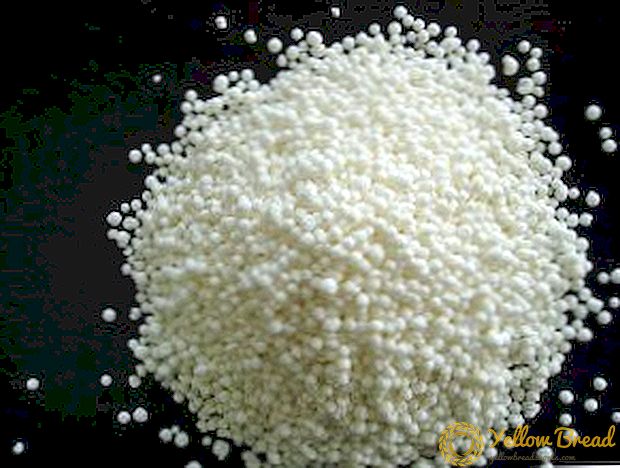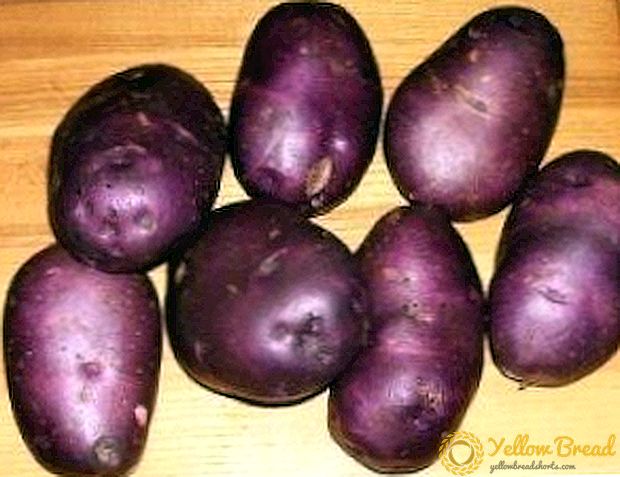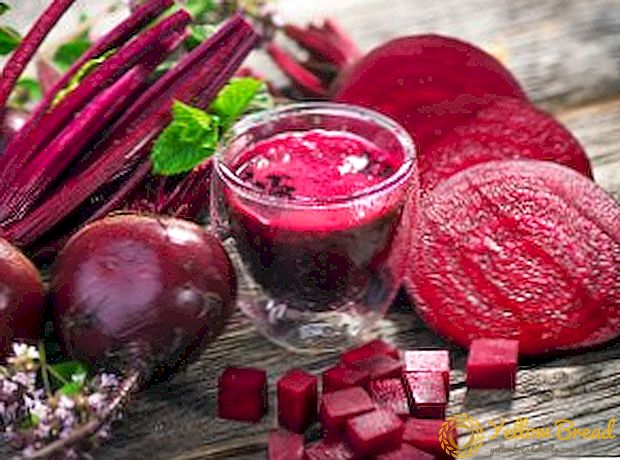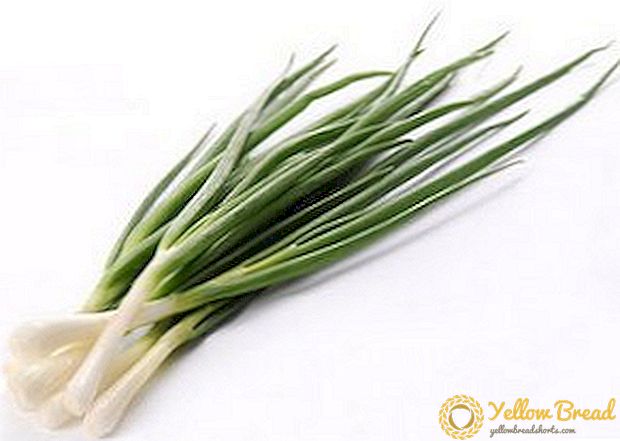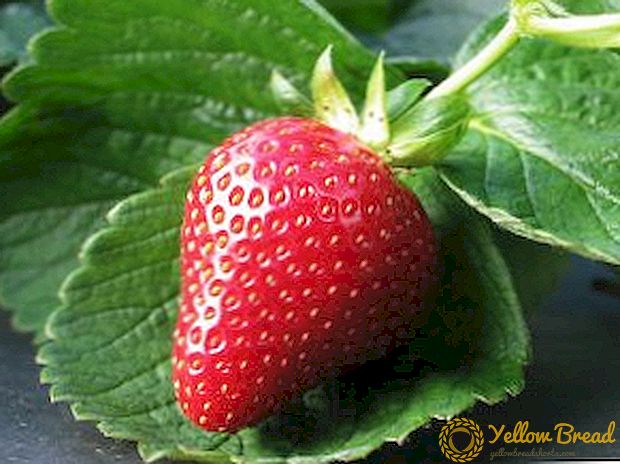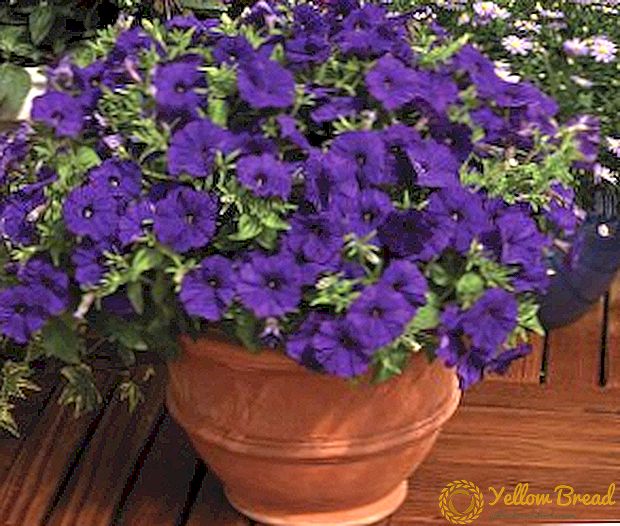 It is difficult to find a summer resident, in the area of which a tasty and fragrant raspberry would not grow. Together with currants, strawberries and other useful plants, it takes pride of place in almost any garden. Today, there are more than 120 different varieties of plants, but most people are only interested in large-shrubs with large and bright berries. These include the Polka raspberry variety (or "Shelf"), which will be discussed later.
It is difficult to find a summer resident, in the area of which a tasty and fragrant raspberry would not grow. Together with currants, strawberries and other useful plants, it takes pride of place in almost any garden. Today, there are more than 120 different varieties of plants, but most people are only interested in large-shrubs with large and bright berries. These include the Polka raspberry variety (or "Shelf"), which will be discussed later.
- Breeding history
- Description and characteristics of the variety
- Features of growing raspberries
- Landing spot
- Optimum soil
- Selection of seedlings and planting "Polka"
- How to provide the right care?
- Watering
- Top dressing
- Soil care
- Garter
- Pruning
- Disease treatment
- How to prepare the plant for winter
- Pros and cons varieties
- Polka Breeding Rules
Breeding history
This raspberry variety was bred in 1993 by Polish breeder Jan Danek who works at the Brzezno Horticultural Research Station. All that needed to be done to obtain a plant was to pollinate an “Autumn Bliss” variety with experimental samples of P89141. Nowadays raspberry "Polka" is one of the most cultivated remontant varieties in industrial gardening.
Description and characteristics of the variety
"Polka" refers to mid-growing raspberry varieties (the bush grows to 1.5-1.8 m), the fruiting of which begins from the end of July and lasts until the first frost. It is distinguished by high yield (on average it is up to 4 kg from 1 bush) and the ability to ripen berries at temperatures from 0 ° C to -2 ° C.  In addition, you can collect them twice a year, because in addition to the main crop, last year's shoots give fruit in early summer. Berries of the specified grade - large, bright red and extended to a bottom, on the sun give characteristic shine. On average, one berry weighs 5-7 g. It has dense and juicy pulp, small drupe. The taste of the fruit is sweet, but with a slight acidity and a very rich aroma. They are waiting in the wings on brushes formed by 6-10 berries.
In addition, you can collect them twice a year, because in addition to the main crop, last year's shoots give fruit in early summer. Berries of the specified grade - large, bright red and extended to a bottom, on the sun give characteristic shine. On average, one berry weighs 5-7 g. It has dense and juicy pulp, small drupe. The taste of the fruit is sweet, but with a slight acidity and a very rich aroma. They are waiting in the wings on brushes formed by 6-10 berries.
Shoots varieties have thorns, but they are all small, soft and do not cause any inconvenience. When growing raspberries for personal use, you can leave part of the shoots for the next year, which will ensure the said double harvest.
However, when growing plants on an industrial scale, such a decision is inappropriate, since it is a big burden on the bush.In this case, it is desirable to cut the shoots annually (completely) and collect only the main crop. In this case, the ripening of raspberries "Polki" will be profitable from a commercial point of view, of course, subject to proper care, in particular, and pruning. 
Features of growing raspberries
As with the cultivation of other “summer” plants, before planting “Polka”, it is necessary to choose the right place and prepare a substrate in which the selected seedlings can grow and develop as efficiently as possible.. Now about everything in order.
Landing spot
An ideal place for planting the described variety is a well-lit area with no overgrowth of other plants and it is well blown by the wind. Nevertheless, try not to place the raspberries in a strong sun, otherwise the berries will get serious burns. The first fruits that appear are the most vulnerable because they are not covered by leaves.while later ones will already have their own protection in the form of sheet plates. 
Optimum soil
"Polka" prefers neutral or slightly acidic soil, although in general it is unpretentious and can grow on almost any soil.The fact is that for her the composition of the land is not so important as the subsequent feeding in the form of a planting bed of humus (1 bucket) and azofoski (4 tablespoons) pledged to the bottom.
If you are going to plant your raspberries in autumn, then the soil should be prepared for 1.5-2 months, spreading evenly on the site a mixture consisting of 70 g of superphosphate, 20 kg of manure and 50 g of potassium sulfate (per 1 m²).  Before spring planting, planting pits (40 cm in diameter and 50 cm deep) should be dug out in two weeks, laying in them the top layer of soil mixed with fertilizer (take the same proportions as for the autumn planting).
Before spring planting, planting pits (40 cm in diameter and 50 cm deep) should be dug out in two weeks, laying in them the top layer of soil mixed with fertilizer (take the same proportions as for the autumn planting).
Selection of seedlings and planting "Polka"
After reviewing the peculiarities of the Polka raspberry, if you are satisfied with the general description of this variety and its yield from a single shrub, it's time to move on to purchase seedlings. Of course, to obtain good planting material, such purchases are permissible only in specialized stores or special garden nurseries.Even if you find a trusted supplier, you need to know what to look for when buying it.
First of all, estimate the size of the bush and the number of shoots on it, since small seedlings are more viable, even if they are only 2-3 shoots of average thickness. Do not forget to pay attention to the roots of the seedling: they must be well developed and thick, without damaged or dried parts. Do not pay attention to the specimens with woody growths and peeling, since these features are the first signs of cancer.  At the base of the shoot of the selected seedling there should be at least three buds, from which the fruit bearing branches develop. In addition, a good planting material shoots surface is absolutely clean, without spots, cracks and black dots.
At the base of the shoot of the selected seedling there should be at least three buds, from which the fruit bearing branches develop. In addition, a good planting material shoots surface is absolutely clean, without spots, cracks and black dots.
If your chosen copy meets all the specified requirements - you can safely buy it and proceed to the landing.
First of all, always adhere to the raspberry planting scheme, especially if you are going to plant many bushes on the site. The optimal inter-row width is 1.5 m, with a distance of 0.5-1 m between adjacent plants.However, it should be borne in mind that in the presence of attacks there will be gaps and in this case the distance between them will be more significant - about two meters.
Suppose you have already dug pits and brought complex organic fertilizers to their bottom (for example, Agroprirost), now you just have to put a seedling in it, gently straightening its roots and cover it with earth. But even here there are some nuances: it is necessary to lay the plant in a horizontal position so that the replacement bud is 3-5 cm below the soil level.  Once the soil has completely covered the roots of the plant, it is necessary to tamp it down with a foot, and then form a hole and pour a bucket of water into it, and after completely absorbing moisture, hammer the hole with straw, peat or fresh earth. The seedling itself at a height of 35-40 cm from the surface should be cut.
Once the soil has completely covered the roots of the plant, it is necessary to tamp it down with a foot, and then form a hole and pour a bucket of water into it, and after completely absorbing moisture, hammer the hole with straw, peat or fresh earth. The seedling itself at a height of 35-40 cm from the surface should be cut.
It is advisable to carry out planting of landing material in dry and calm weather, placing rows under the landing from the north to the southern part of the territory.
How to provide the right care?
From the moment of planting begins the period of active care of raspberries, which includes regular watering, fertilizing, pruning and other equally important agrotechnical measures. How to cope with this task - we will now tell.
Watering
In the Polka variety, the root system is located very close to the soil surface, therefore there is a risk of its quick drying. To avoid this, the plant is regularly and abundantly watered, bringing 2-3 buckets of water under one bush. The soil should get wet 30-40 cm deep, therefore, to achieve a similar result, it is best to use a drip system for watering.  The main watering of the shrub falls on the period of its flowering, and the last time the liquid under the bushes is made shortly after harvesting. The frequency and intensity of irrigation can be adjusted depending on weather conditions. On especially hot days, raspberries must be shaded, because even with drip irrigation, the berries will “roast” in the sun.
The main watering of the shrub falls on the period of its flowering, and the last time the liquid under the bushes is made shortly after harvesting. The frequency and intensity of irrigation can be adjusted depending on weather conditions. On especially hot days, raspberries must be shaded, because even with drip irrigation, the berries will “roast” in the sun.
Top dressing
With the arrival of the first warm spring days, the active growth of "Polka" begins, which means that the first feeding should fall in April. Potash and phosphate compounds (for example, the aforementioned azofosc) are used to fertilize plants during this period, in a ratio of 100 g per 1 m².
Since the beginning of summer, organic dressings are carried out three times. (in a month), using ammonium nitrate (30 g), superphosphate (60 g) and potassium salt (40 g) diluted in 1 liter of pure water for foliar fertilizers. For root feeding, you will need 3 kg of humus, 4 g of phosphorus and 6 g of nitrogen and potassium each. All components are mixed and scattered on the site in the proportion of 1.5 kg per 1 m².  Very important for the "Polka" is the autumn dressing, performed 1 time in 3 years (on too poor soil - annually). It provides for the scattering of sheep, horse or cow manure in a plot of 5 kg of organic matter per 1 m² of territory. This dressing usually occurs at the beginning of September; it is this that influences the formation of the future raspberry crop. In parallel, growth processes are slowed down and the culture slowly prepares for winter rest.
Very important for the "Polka" is the autumn dressing, performed 1 time in 3 years (on too poor soil - annually). It provides for the scattering of sheep, horse or cow manure in a plot of 5 kg of organic matter per 1 m² of territory. This dressing usually occurs at the beginning of September; it is this that influences the formation of the future raspberry crop. In parallel, growth processes are slowed down and the culture slowly prepares for winter rest.
Fertilizing plants is best done after watering, before loosening the soil.
Soil care
Since the described variety needs well-ventilated soil, it will not work without loosening it.At the beginning of the year, this procedure is carried out before the beginning of the growing season (the loosening depth under the bushes is up to 7 cm, and between adjacent rows this value can reach 12 cm).  In some cases, loosening is best done up to 5 cm deep, since due to the proximity of the root system to the surface there is a risk of damage. During the season, this procedure is repeated up to 5 times, during which it is disposed not only of the crust on the surface of the ground, but also of all the weeds that come to hand.
In some cases, loosening is best done up to 5 cm deep, since due to the proximity of the root system to the surface there is a risk of damage. During the season, this procedure is repeated up to 5 times, during which it is disposed not only of the crust on the surface of the ground, but also of all the weeds that come to hand.
Moistened and loosened soil can be mulched sawdust, peat or compost, which are rotting, become an excellent source of nutrients. In winter, the mulch will help to avoid freezing of the soil, and in the summer will not allow it to overheat. After wintering, peat or sawdust is mixed with the top layer of earth.
Garter
Unlike other middle-class varieties, the Polka raspberry does not need a garter so much, although in some cases its support with a trellis is simply necessary. With strong gusts of wind, strong enough shoots can not always survive, therefore columns of 1.5-2 m long are installed in a row.Raspberry shoots are tied up to a wire stretched between them at a height of 35 cm, 1 or 1.5 meters. Annual stalks are fixed to the trellis only for the winter. 
Pruning
Like all raspberry bushes, the Polka variety cannot do without pruning. But the method chosen in this case will depend on how many raspberry crops you want to harvest. The main thing to remember when forming is that 5-7 main shoots should be kept on the bush.
When growing two yields, the plants must be cut in spring or late autumn. (typical for the southern regions), removing the part of the shoot on which the fruit grew or the stems are damaged. The left part will be enough to form the summer harvest, while the young one-year-olds will be able to ripen the autumn one.  If the second gathering of berries is no good to you, then the pruning of the bushes is carried out in November, removing all the stems at the level of the soil and leaving no stumps. There is no need to hurry with pruning, because before the soil freezes, the culture continues to take from it useful and nutrients that will be useful to it for normal development next year.Fully cropped raspberries in the fall become more resistant to diseases, and its overall performance improves significantly. After removing all the stems from the bush, they must be taken out of the raspberries and burned.
If the second gathering of berries is no good to you, then the pruning of the bushes is carried out in November, removing all the stems at the level of the soil and leaving no stumps. There is no need to hurry with pruning, because before the soil freezes, the culture continues to take from it useful and nutrients that will be useful to it for normal development next year.Fully cropped raspberries in the fall become more resistant to diseases, and its overall performance improves significantly. After removing all the stems from the bush, they must be taken out of the raspberries and burned.
Disease treatment
"Polka" is practically not susceptible to the most common "raspberry" diseases and pests, for example, to rot (especially sulfur) or spider mite. Also, worms and other minor pests are not found on it, since flowering and fruiting of bushes begin later than in the main part of remontant varieties.
The most vulnerable place of the variety is the root, and the most dangerous disease is cancer, manifested as growths on the root system. For the prevention of this disease in the ground make gypsum and physiologically acidic phosphate-potassium fertilizers, but to treat cancer is useless,because after 1-2 years, the existing growths will still fall apart, and the causative agent of the disease will move to the ground, where it will be able to maintain vital activity for 2-3 years.  With high acidity of the soil and potassium deficiency, the bush can react with redness of the foliage, although the same peculiarity is characteristic with the lack of nutrition. Other possible diseases of "Polka" include chlorosis, white and purple spotting, anthracnose. For their treatment and prophylaxis, spraying with a 0.1% solution of Methylmercaptophos (carried out before flowering), 1% Bordeaux mixture (before budding) and 1% solution of colloidal sulfur (during the formation of buds and after picking berries) are used.
With high acidity of the soil and potassium deficiency, the bush can react with redness of the foliage, although the same peculiarity is characteristic with the lack of nutrition. Other possible diseases of "Polka" include chlorosis, white and purple spotting, anthracnose. For their treatment and prophylaxis, spraying with a 0.1% solution of Methylmercaptophos (carried out before flowering), 1% Bordeaux mixture (before budding) and 1% solution of colloidal sulfur (during the formation of buds and after picking berries) are used.
In most cases, for the recovery of raspberry bushes enough to fertilize them before watering wood ashes.  If raspberry bushes still attacked a stem fly, raspberry beetle, weevil, aphid or kidney moth, then standard insecticides will help to fight against them: Karbofos, Iskra-M, Fufanon or Inta-Vir.
If raspberry bushes still attacked a stem fly, raspberry beetle, weevil, aphid or kidney moth, then standard insecticides will help to fight against them: Karbofos, Iskra-M, Fufanon or Inta-Vir.
How to prepare the plant for winter
If the bush is not cut for the winter, which, as we said, is better done, then it should be mulched using peat, basalt cotton wool, moss or coconut chips. It is extremely undesirable to use tyrs for this purpose, since it will pull moisture, creating an excellent environment for the development of bacteria and subsequent decay. For additional protection, fir spruce branches can be placed on top of the mulch layer, especially if severe winter is expected.
Leaving the bushes uncut, be sure to clean the leaves of their shoots, which can be done using mittens, which is carried out through the stem from the bottom up. It is better not to move in the opposite direction, otherwise there is a risk of seriously damaging the kidneys. If the leaves remain in place, then under the influence of precipitation they will start to rot very quickly, which will have an extremely negative effect on the kidneys. Two growing nearby bush bend to each other at a level of 50 cm from the ground and fixed in this position.  However, it is better to cut the “Polka” completely, especially if you are not going to “stretch” the harvest for the next year. A plot with cut shoots is covered with a layer of sawdust or straw, 20 cm thick. In winter, the raspberry can be additionally covered with snow or special agrofibre.
However, it is better to cut the “Polka” completely, especially if you are not going to “stretch” the harvest for the next year. A plot with cut shoots is covered with a layer of sawdust or straw, 20 cm thick. In winter, the raspberry can be additionally covered with snow or special agrofibre.
Pros and cons varieties
When planting any plant on your plot, it is important to immediately identify all its advantages and disadvantages, because it is likely that there will be more of the latter and you will have to abandon this idea altogether. Nevertheless, this is not about the "Polka", because in this class just a lot of advantages. In particular, they include:
- the perfect appearance of the fruit, so that this raspberry is considered the best European dessert variety;
- high yields (there were cases when up to 12 tons of raspberries were harvested from 1 ha);
- the duration of fruiting (good feeding will allow you to harvest twice a year, and without significant load on the bush itself);
- high resistance of the variety to pests and diseases;
- good transportability, keeping quality and dry separation of the berries, so that they even look fresh after freezing;
- the absence of serious thorns, which greatly facilitates the process of harvesting;
- the fruits of "Polka" are excellent for all kinds of conservation for both classic jam, and for fruit drinks or jelly;
- profitability of a grade thanks to the favorable period of fructification.
Agree, a rather big list of advantages, although it would be unfair not to recall certain minuses, which, by the way, are much smaller. Raspberry "Polka", with the description of the variety that you just got acquainted with, is not very frost resistant and does not tolerate summer temperature rises (up to + 35 ° С and higher), as a result of which the collected berries will not look so attractive in the photo (this is shown by numerous reviews of culture).  In addition, resistance to the most common diseases of the aerial parts is overshadowed by an increased risk of root diseases: cancer, rot, etc.Do not forget about the need for abundant feed, because with a lack of potassium, nitrogen or organic matter, the rate of formation of new shoots will only worsen. Otherwise, the described variety is a good option for breeding on your plot, and it does not matter if you plant raspberries for personal use or for commercial purposes.
In addition, resistance to the most common diseases of the aerial parts is overshadowed by an increased risk of root diseases: cancer, rot, etc.Do not forget about the need for abundant feed, because with a lack of potassium, nitrogen or organic matter, the rate of formation of new shoots will only worsen. Otherwise, the described variety is a good option for breeding on your plot, and it does not matter if you plant raspberries for personal use or for commercial purposes.
Polka Breeding Rules
The variety "Polka" is propagated in two ways - through root shoots (more advantageous from a temporary point of view) and through the use of green cuttings harvested in late spring. In the first case, with the arrival of heat (although it is possible to perform the procedure in the fall), a part of the bush (10–20 cm in diameter) is dug out from the center of a two or three year old plant and moved to another place. The remaining roots in the soil for the season will again give up to 20 new offspring (appear gradually, during the growing season).  For breeding "Polka" by cutting the perfect annual shoots (about 3-5 cm). Such a stalk should be carefully cut and get together with the earthy clod.Do not forget to treat the cut place with charcoal and place it in light and nutritious soil for better rooting. In open ground, the segment can be planted in about a month.
For breeding "Polka" by cutting the perfect annual shoots (about 3-5 cm). Such a stalk should be carefully cut and get together with the earthy clod.Do not forget to treat the cut place with charcoal and place it in light and nutritious soil for better rooting. In open ground, the segment can be planted in about a month.
As you can see, there is nothing supernatural in the reproduction of the variety "Polka", as, indeed, in all cultivation of a culture, and very soon it will be possible to enjoy large, tasty raspberries.

